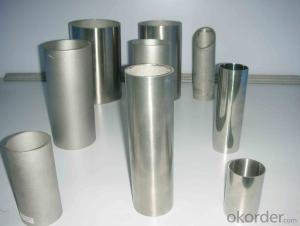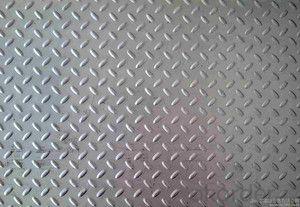Polished 316 Stainless Steel Sheet 316l
- Loading Port:
- Shanghai
- Payment Terms:
- TT OR LC
- Min Order Qty:
- 2 m.t.
- Supply Capability:
- 5000 m.t./month
OKorder Service Pledge
OKorder Financial Service
You Might Also Like
Specification
polished stainless steel sheet 316l
1:Basic info
Material | 304,304L,316L,309s,310s,321,409,904L etc |
Grade | 316l |
Type | Stainless steel plate panels |
Brand | TISCO,ZPSS,BAO STEEL,LISCO, |
Thickness | 0.3mm-3.0mm for cold rolled(normal tolerance) 3.0mm-60mm up for hot rolled(normal tolerance) |
Width | Standard width:1000mm,1220mm(4feet)1500mm,1800mm(5feet),.customized sizes can be made |
Length | Standard length:2000mm,2440mm(8feet)3000mm,3048mm(10feet),6000mm. Customized sizes can be made |
Surface | 2B,No.1,BA,Mirror Polished,Hairline,No.4,8K etc |
Standard | AISI,JIS,SUS,ASTM,GB |
Trade Term | FOB ShangHai,CIF,CFR,Ex-w |
Delivery | 5-10 days after receive the deposit base or as the quantity required |
Payment term | 30%TT advance,70%TT against copy of B/L 30%TT advance,70%TT L/C at sight 100% L/C at sight |
MOQ | 1 ton |
2:Features
1)Corrosion resistance
2)Oxidation resistance
3)High temperature resistance
4)High chromium nickel composition,can continuous operation under high temperature
3: Chemical composition
C ≤0.08
Si ≤1.00
Mn ≤2.00
P ≤0.035
S ≤0.030,
Ni 19.0-22.0
Cr 24.0-26.0
4:Pictures show



Click here to get more information
![]()
1. HS CODE: 7219339000,7219320000,7219220000,7219110000
2. Trade term: FOB,CNF,CIF
3. Payment term: 30% by T/T as down payment balance against B/L copy or 100% LC at sight.
4. Delivery time: Within 3-15 working days after received deposit or LC draft.
5. A copy of mill test certificate will be provided with shipment.
- Q: What's the difference between the 304 stainless steel plate and the 310S stainless steel plate?
- 304 is a versatile stainless steel which is widely used in the manufacture of equipment and parts requiring good overall performance (corrosion resistance and formability). In order to maintain the inherent corrosion resistance of stainless steel, steel must contain more than 18% chromium, more than 8% of the nickel content. 304 stainless steel is a brand of stainless steel produced according to the ASTM standard in the United states.310S stainless steel austenitic chromium nickel stainless steel has good oxidation resistance, corrosion resistance, because the higher percentage of chromium and nickel, which has much better creep strength, can continuously work under high temperature, good heat resistance, softening temperature is more than 800[1], and the allowable stress continued to decrease, the highest use temperature of 1200 DEG C. For Ni (Ni), chromium (Cr) content is high, with good oxidation resistance, corrosion resistance, acid and alkali resistance, high temperature performance, high temperature resistant steel dedicated to the manufacture of electric furnace tube and so on, increase the amount of carbon austenitic stainless steel, due to the solid solution strengthening effect to the strength improved, chemical composition characteristics of austenitic stainless steel is chrome, nickel based addition of molybdenum and tungsten, niobium and titanium elements, as its face centered cubic structure, and strength and high creep strength at high temperature.
- Q: What is the specific heat capacity of stainless steel sheets?
- The specific heat capacity of stainless steel sheets can vary depending on the specific grade and composition of the stainless steel. However, on average, the specific heat capacity of stainless steel is around 500 J/kg°C. This means that for every kilogram of stainless steel, it would require 500 joules of energy to raise the temperature by 1 degree Celsius. It is important to note that this value may not be exact for all types of stainless steel, so it is recommended to consult specific technical data or reference materials for accurate and precise values.
- Q: Are stainless steel sheets resistant to abrasion?
- Yes, stainless steel sheets are generally resistant to abrasion. Stainless steel is known for its high strength and durability, making it less prone to scratches and wear compared to other materials. It has a smooth surface that can withstand friction and abrasion, making it suitable for various applications where resistance to scratches and wear is required. However, it is important to note that the level of resistance can vary depending on the specific grade and finish of stainless steel used.
- Q: Can stainless steel sheets be used for outdoor furniture?
- Yes, stainless steel sheets can be used for outdoor furniture. Stainless steel is highly resistant to corrosion and rust, making it a durable and suitable material for outdoor use. It is also easy to clean and maintain, making it an ideal choice for outdoor furniture that is exposed to various weather conditions.
- Q: Can stainless steel sheets be used in medical applications?
- Yes, stainless steel sheets can be used in medical applications. Stainless steel is a popular choice in the medical field due to its excellent corrosion resistance, durability, and ease of sterilization. It is widely used in medical devices, surgical instruments, and implantable components due to its ability to withstand harsh sterilization processes such as autoclaving, which is crucial for maintaining cleanliness and preventing infections. Additionally, stainless steel is biocompatible, meaning it does not react with the body's tissues and does not cause any harm or adverse reactions. Overall, stainless steel sheets are a reliable and versatile material for various medical applications.
- Q: What is the maximum size available for stainless steel sheets?
- The maximum size of stainless steel sheets depends on various factors, including the supplier's manufacturing capabilities and the customer's specific requirements. Standard sizes for stainless steel sheets can vary based on the thickness and grade of the material. Typically, stainless steel sheets can be obtained in standard sizes ranging from 4 feet by 8 feet (1220mm x 2440mm) to larger dimensions like 5 feet by 10 feet (1524mm x 3048mm). However, it is also possible to find custom sizes or oversized sheets that surpass these dimensions, especially for industrial or specialized purposes. It is important to consider that larger sizes may present additional challenges, such as increased weight and difficulties in handling. Furthermore, the availability of specific sizes may differ among suppliers. Therefore, it is advisable to consult with a stainless steel sheet supplier or manufacturer to ascertain the exact maximum size options they offer.
- Q: Are stainless steel sheets suitable for water treatment facilities?
- Indeed, water treatment facilities find stainless steel sheets to be highly suitable. Known for its corrosion resistance, stainless steel proves to be essential in an environment where water and chemicals are consistently present. It effectively resists rust and degradation, guaranteeing the longevity and durability of the sheets. Moreover, stainless steel boasts ease of cleaning and maintenance, rendering it an ideal choice for facilities that necessitate regular hygiene and sanitation. Furthermore, this material exhibits remarkable resistance to heat and extreme temperatures, ensuring its performance even in demanding conditions. Additionally, stainless steel is non-reactive, meaning it does not release any harmful substances into the water during treatment processes. Consequently, it stands as a safe and reliable option for water treatment applications.
- Q: How do I prevent corrosion under insulation on stainless steel sheets?
- In order to avoid corrosion under insulation on stainless steel sheets, there are several measures that can be taken: 1. Make careful choices when selecting insulation materials. Opt for materials that are compatible with stainless steel and have a low water absorption rate. Avoid using materials that can cause galvanic corrosion when they come into contact with stainless steel. 2. Ensure that the insulation thickness is adequate to prevent moisture condensation on the surface of the stainless steel. Moisture condensation can trap moisture and speed up the corrosion process. Seek advice from an insulation specialist to determine the appropriate thickness for your specific situation. 3. Install vapor barriers between the insulation and the stainless steel sheets. These barriers act as a moisture barrier and prevent water or moisture from entering, which can lead to corrosion. Vapor barriers can be made from materials like foil or plastic films. 4. Pay attention to proper installation techniques to avoid any gaps or areas where moisture can accumulate. Focus on the joints, seams, and connections, ensuring that they are tightly sealed to prevent water from penetrating. 5. Regularly inspect and maintain the insulation system to detect any signs of damage, such as leaks or deterioration. Promptly repair any damaged insulation or vapor barriers to prevent moisture from reaching the stainless steel surface. 6. Provide sufficient ventilation to prevent moisture buildup in enclosed spaces. Good airflow can help reduce the occurrence of condensation and subsequent corrosion. 7. Consider using cathodic protection methods, such as sacrificial anodes or impressed current systems, to protect stainless steel sheets from corrosion. These methods generate an electrical current that counteracts the corrosion process, extending the lifespan of the stainless steel. It is important to consult with corrosion specialists or insulation experts to ensure that the best practices are implemented for your specific application and environment.
- Q: How do I install stainless steel sheets?
- To install stainless steel sheets, start by measuring and marking the area where the sheets will be installed. Next, ensure the surface is clean and free from dust or debris. Apply a strong adhesive or use screws to secure the sheets to the surface, making sure they are aligned properly. If needed, cut the sheets to fit using appropriate tools such as a metal shear or circular saw with a metal-cutting blade. Finally, ensure all edges and seams are properly sealed to prevent water or moisture infiltration.
- Q: What is the area of stainless steel plate?
- First of all, I said, can not be sold by area, because the thickness of the price is not the same, I said the weight is how to draw, take SUS304 steel:Length (m) * width (mm) * thickness (mm) * density (7.93) /1000= weight
Send your message to us
Polished 316 Stainless Steel Sheet 316l
- Loading Port:
- Shanghai
- Payment Terms:
- TT OR LC
- Min Order Qty:
- 2 m.t.
- Supply Capability:
- 5000 m.t./month
OKorder Service Pledge
OKorder Financial Service
Similar products
Hot products
Hot Searches
Related keywords


























